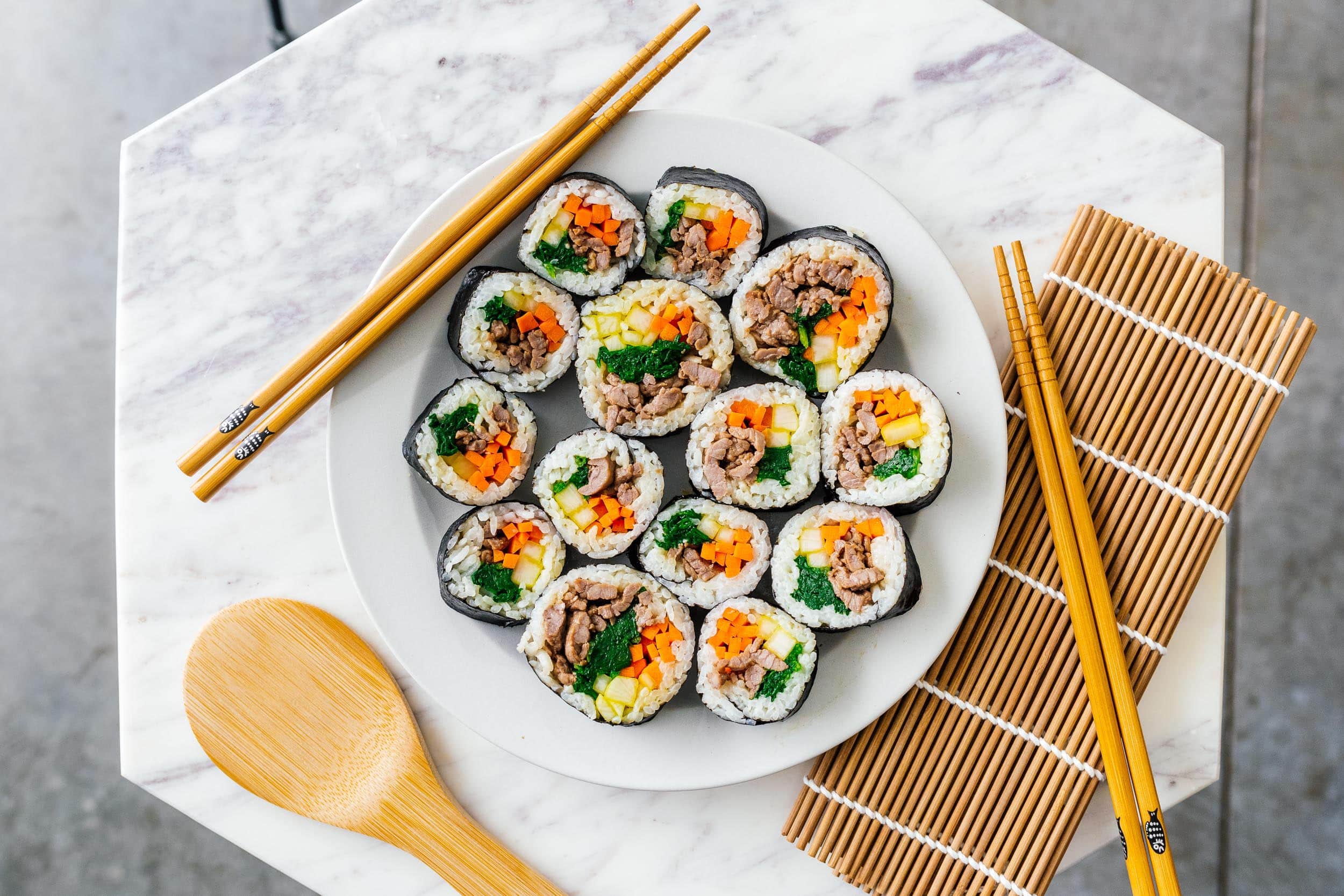Last week, while exploring the frozen aisle at Trader Joe’s, I stumbled upon an intriguing find: frozen kimbap. Naturally, I had to give it a try! Although I was unaware that frozen kimbap existed, it turns out it’s quite popular in Korea and can be found in many Korean grocery stores. After trying it at home, we were pleasantly surprised by its flavor. If you’re unable to locate it in stores or prefer a fresher option, keep reading for a homemade recipe!
How to Prepare Kimbap
-
Season the Rice: Start by sprinkling salt and toasted sesame oil over warm short-grain rice and mix gently.
-
Prepare the Beef: Marinate thinly sliced beef with soy sauce, sugar, and toasted sesame oil. Cook over medium-high heat until fully cooked; then set aside.
-
Blanch the Spinach: Quickly blanch spinach in boiling water before squeezing out excess moisture and seasoning with salt and a dash of toasted sesame oil.
-
Prepare Carrots: Massage matchstick-cut carrots with salt to soften them slightly; then squeeze out any extra water before sautéing them briefly in toasted sesame oil.
-
Cut Daikon Radish: Trim daikon radish into spears that fit neatly onto your seaweed sheets.
-
Roll It Up: Lay a sheet of seaweed shiny side down on a rolling mat; spread rice evenly across leaving some space at the top edge. Place your fillings along the center of the rice-covered seaweed sheet and roll tightly using the mat as support.
-
Slice & Serve: Cut your rolled kimbap into ¼-inch slices and arrange them on a plate for serving.
Essential Ingredients for Kimbap
For this classic version of kimbap, you’ll need:
- Rice: Short-grain rice is ideal due to its soft texture.
- Seaweed Sheets: Use large roasted sheets similar to those used for sushi.
- Danmuji (Pickled Daikon): This bright yellow pickled radish can be purchased or made at home (make sure to prepare it 24 hours ahead).
- Carrots & Spinach: Carrots should be cut into matchsticks while spinach is blanched.
- Beef: Thinly sliced steak marinated like bulgogi adds flavor.
- Toasted Sesame Oil: A key ingredient that enhances overall taste!
Review of Trader Joe’s Kimbap
Spoiler alert—I loved Trader Joe’s frozen kimbap! My partner Mike was indifferent initially but agreed after tasting it that they were quite good too! We started with one roll but enjoyed it so much that we bought two on our next visit—only to find they were sold out during our subsequent trip due to unexpected demand! Unfortunately, supply chain issues mean they won’t restock until November—what bad luck!
How To Enjoy Frozen Kimbap
Having never encountered frozen kimbap before, I was curious about how well it would hold up after freezing since it’s typically served fresh due to its delicate rice texture which can dry out when cold. The instructions suggest microwaving for two minutes followed by one minute of resting time—after which you simply enjoy without any dipping sauces since it’s already perfectly seasoned!
What Exactly Is Kimbap?
If you’re wondering what kimbap is all about—it’s essentially Korea’s answer to sushi rolls made from cooked ingredients wrapped in seasoned rice and seaweed (the name “kimbap” translates directly as “seaweed rice”). Unlike Japanese sushi rolls which often feature raw fish or seafood options, kimbaps are always prepared using cooked proteins making them perfect for snacking or picnics thanks to their portability.
The Kimbap Controversy
Trader Joe’s version gained viral attention on TikTok leading many users either praising or criticizing their experience—a phenomenon that sparked significant interest online! Some customers reported buying multiple rolls per visit while others noted how easy homemade versions are compared with store-bought options available at Korean markets.
When Will More Be Available?
Trader Joe’s has indicated more stock will arrive in November; however some locations may still have inventory left so check around if you’re eager! Since these rolls come from Korea there may be delays based on production timelines too.
Where Else Can You Find Frozen Kimbap?
If you live near an Asian grocery store check their freezer section—you might discover various brands offering frozen versions there!
Fresh Options Available
Freshly made kimpab can often be found ready-to-eat at Korean grocery stores or ordered from local restaurants specializing in Korean cuisine—especially if you’re situated near areas with larger Korean communities where dedicated establishments exist just for this dish!
Making Your Own At Home
Absolutely! Many Koreans enjoy preparing this dish themselves—it does take some time but assembling everything is straightforward once you’ve prepped all components properly! Common fillings include pickled radish (danmuji), carrots cucumber egg spinach imitation crab meat burdock fish cake bulgogi tuna salad kimchi—the combinations are endless depending upon personal preference! Have you tried Trader Joe’s offerings? Are you planning on making your own soon? Either way happy cooking adventures await ahead!
Recipe Overview
Best Homemade Kimbap
Serves: 4
Prep Time: 1 hour
Cook Time: None
Total Time: 1 hour
Ingredients:
- 4 cups cooked short-grain rice
- ½ tsp kosher salt (to taste)
- 4 tsp toasted sesame oil
- ½ lb thinly sliced steak
- 2 tsp soy sauce
- 2 tsp sugar
- 8 oz baby spinach
- Large carrot cut into matchsticks
- Strips danmuji (pickled daikon)
- Seaweed sheets
Instructions:
1) Season warm rice mixing together salt & sesame oil letting cool while prepping other ingredients… (Continue following detailed steps provided above)
Enjoy crafting delicious homemade meals filled with love—and don’t forget those essential flavors make all difference when creating delightful dishes like these delightful wraps known as “KIMBAP”!

